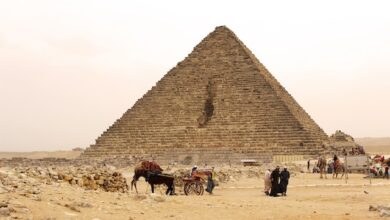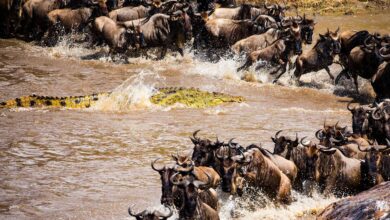Discover Tarangire National Park
A Hidden Gem in Tanzania

If you’re dreaming of an unforgettable safari experience, look no further than Tarangire National Park.
Nestled in the heart of Tanzania, this park is a treasure trove of wildlife, stunning landscapes, and unique experiences.
Known for its massive elephant herds and breathtaking baobab trees, Tarangire offers a more intimate and less crowded alternative to the popular Serengeti.
Let’s explore everything this incredible destination has to offer!
A Brief Overview of Tarangire National Park
Location and Size
Tarangire National Park is located in Tanzania’s Manyara Region, about 120 kilometres (75 miles) southwest of Arusha.
Covering approximately 2,850 square kilometres (1,100 square miles), it is the sixth-largest national park in Tanzania.
The park is characterized by its diverse ecosystems, which include savanna, river valleys, and swamps.
History
Established as a national park in 1970, Tarangire was initially designated as a game reserve in 1957.
The park’s name comes from the Tarangire River, which serves as a vital water source for wildlife during the dry season.
Over the years, conservation efforts have helped to protect the park’s unique flora and fauna, making it a must-visit destination for wildlife enthusiasts.
Also Read: Rift Valley Lakes From Naivasha to Nakuru
Why Visit Tarangire National Park?
1. Incredible Wildlife Viewing
One of the main draws of Tarangire National Park is its rich wildlife. The park is home to a staggering variety of animals, including:
- Elephants: Tarangire is famous for its large elephant herds, which peak at around 5,000 during the dry season. You can often witness groups of up to 300 elephants congregating near the Tarangire River.
- Big Cats: The park is also home to predators such as lions, leopards, and cheetahs. Spotting these magnificent creatures in their natural habitat is a thrilling experience.
- Other Mammals: In addition to elephants and big cats, you can find zebras, wildebeests, giraffes, buffaloes, and various antelope species, including oryx and eland.
- Birdwatching Paradise: With over 550 bird species recorded, Tarangire is a haven for birdwatchers. Look out for the vibrant lilac-breasted roller, the majestic African fish eagle, and the elusive Kori bustard.
2. The Baobab Trees
One of Tarangire National Park’s most iconic features is its ancient baobab trees.
These remarkable trees can live for over 1,000 years and store large amounts of water, making them a vital resource for wildlife during the dry season.
Their unique shape and size create a stunning backdrop for photographs and add to the park’s enchanting atmosphere.
3. Seasonal Wildlife Migration
While not as famous as the Serengeti’s wildebeest migration, Tarangire hosts its own wildlife migration during the dry season from June to October.
During this time, thousands of animals, including elephants, zebras, and wildebeests, flock to the park in search of water and grazing land.
This spectacle is a photographer’s dream and a must-see for any wildlife enthusiast.
Also Read: Namibia’s Skeleton Coast
Activities to Enjoy in Tarangire National Park
1. Game Drives
Game drives are the most popular way to explore Tarangire National Park. Whether you choose a guided tour or self-drive, you’ll have the chance to see a wide variety of wildlife in their natural habitats.
Early morning and late afternoon are the best times for game viewing, as animals are more active during these cooler hours.
2. Walking Safaris
For a more immersive experience, consider embarking on a walking safari.
Accompanied by a knowledgeable guide, you can explore the park on foot, gaining a deeper understanding of the ecosystem and its inhabitants.
Walking safaris allow you to appreciate the smaller details of the bush, from animal tracks to unique plant species.
3. Birdwatching Tours
If you’re a bird enthusiast, Tarangire is a paradise waiting to be explored. Join a birdwatching tour to discover the park’s diverse avian population.
With over 550 species, you’ll have plenty of opportunities to spot both common and rare birds.
4. Night Drives
While night drives are not permitted within the park, some lodges offer organized night excursions in nearby areas.
This unique experience allows you to see nocturnal animals in action and witness the African night sky in all its glory.
Accommodation Options
Tarangire National Park offers a range of accommodation options to suit every budget and preference:
Luxury Lodges: Several luxury lodges offer an upscale experience with stunning views, gourmet dining, and personalized service.
Mid-Range Camps: Comfortable tented camps offer a great balance of comfort and adventure, allowing you to enjoy the sounds of the bush at night.
Budget Camping: For the adventurous traveller, camping within the park is an option. This allows for a more authentic experience, surrounded by nature.
Best Time to Visit Tarangire National Park
The best time to visit Tarangire National Park is during the dry season, which runs from June to October.
During this period, the vegetation is less dense, making wildlife easier to spot.
The park’s rivers and waterholes attract large numbers of animals, providing excellent viewing opportunities.
Wet Season (November to May): While the wet season brings lush landscapes and fewer tourists, it can make wildlife viewing more challenging as animals disperse in search of food and water.
How to Get to Tarangire National Park
Getting to Tarangire National Park is relatively straightforward.
The park is located about two hours from Arusha, making it an ideal stop on your Tanzanian safari itinerary. You can reach the park by:
- Self-Drive: Renting a car is a popular option for those looking to explore at their own pace.
- Guided Tours: Many tour operators offer packages that include transportation, accommodation, and guided activities.
Conclusion: Your Adventure Awaits at Tarangire National Park
Tarangire National Park is a captivating destination that promises unforgettable wildlife encounters, stunning landscapes, and a chance to connect with nature.
Whether you’re an avid birdwatcher, a wildlife enthusiast, or simply seeking adventure, Tarangire has something for everyone.
So pack your bags, grab your camera, and get ready for an incredible safari experience in one of Tanzania’s hidden gems!
FAQs About Tarangire National Park
What is the entrance fee for Tarangire National Park?
The entrance fee for international visitors is $45 per person per day. Vehicle fees also apply.
Can I self-drive in the park?
Yes, self-driving is allowed in Tarangire National Park, but guided tours are recommended for the best wildlife viewing experience.
What wildlife can I expect to see in Tarangire?
Tarangire is home to elephants, lions, leopards, giraffes, zebras, wildebeests, and over 550 bird species.
Is it safe to walk in Tarangire National Park?
Walking safaris are conducted with trained guides, ensuring safety while allowing you to explore the park on foot.
What should I pack for my trip to Tarangire?
Pack lightweight, neutral-coloured clothing, binoculars, a camera, sunscreen, insect repellent, and a refillable water bottle.
When is the best time to visit Tarangire National Park?
The best time to visit is during the dry season, from June to October, when wildlife congregates around water sources.
Are there accommodations within the park?
Yes, Tarangire offers various accommodations, including luxury lodges, mid-range camps, and budget camping options.
For more information, click here.





